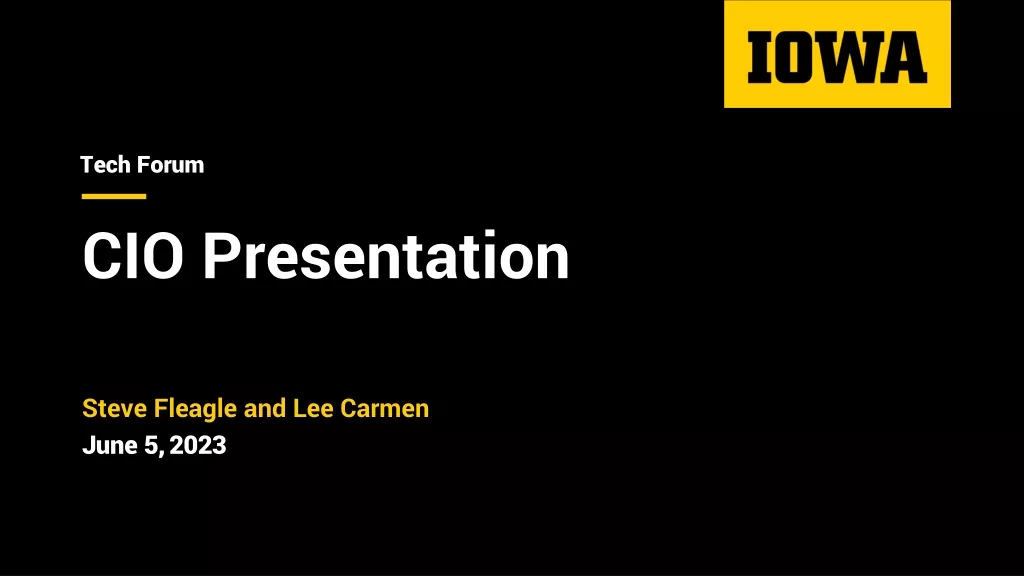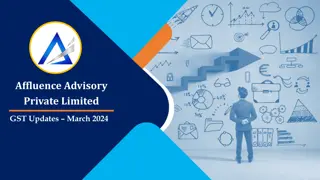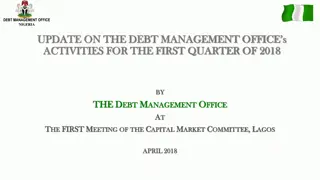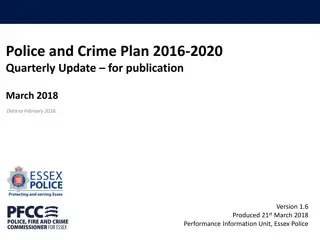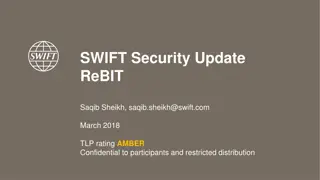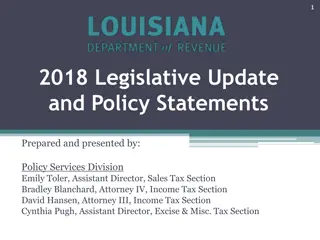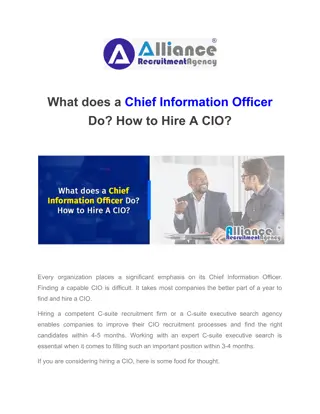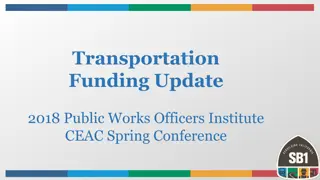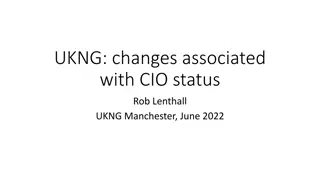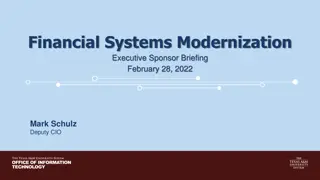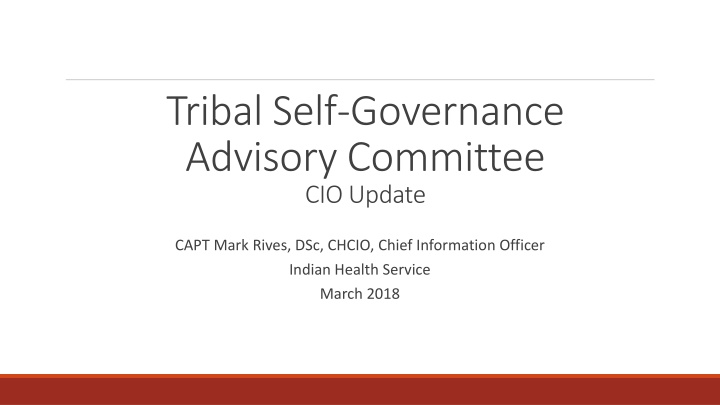
Tribal Self-Governance Advisory Committee CIO Update March 2018
The CIO update from the Tribal Self-Governance Advisory Committee in March 2018 provides insights into the HIT Modernization RFI process, RFI response groupings, evaluation, and next steps. It also highlights ongoing efforts with VA, DoD/MHS, and HHS, along with a notional timeline for system implementation and maintenance.
Download Presentation

Please find below an Image/Link to download the presentation.
The content on the website is provided AS IS for your information and personal use only. It may not be sold, licensed, or shared on other websites without obtaining consent from the author. If you encounter any issues during the download, it is possible that the publisher has removed the file from their server.
You are allowed to download the files provided on this website for personal or commercial use, subject to the condition that they are used lawfully. All files are the property of their respective owners.
The content on the website is provided AS IS for your information and personal use only. It may not be sold, licensed, or shared on other websites without obtaining consent from the author.
E N D
Presentation Transcript
Tribal Self-Governance Advisory Committee CIO Update CAPT Mark Rives, DSc, CHCIO, Chief Information Officer Indian Health Service March 2018
Update on HIT Modernization RFI RFI o Opened around Christmas o Set to close at the first of February but, after questions from potential respondents, we left it open until February. o Goal: Augment, Modernize, or replace o Received over 40 responses o All the big names responded o Current IHS Contractors o Tribal business organizations o Working with IHS Acquisitions o Holidays and other schedule priorities have slowed the review but it s on going. o Responses are very dissimilar but can be grouped into four buckets
RFI Response Groupings Responses Traditional big box EHR platforms (16) New platform, rip & replace the old one Those responses have components that are a challenge to crosswalk and align Variations (Product, Services, Support) Platforms Capabilities Outpatient only, Inpatient and Outpatient, etc. Modules E.g. in-house pharmacy, lab, optometry, ED, etc. Support Services Implementation Support Modernize RPMS (2) Including commercial versions of RPMS Bolt-On reporting & Integration solutions (18) Scoping and requirements development proposals (6) Plus two others
RFI evaluation and Next Steps RFI could ve been more general Tended to ask questions very specific to the issues we are facing Some of it would ve been better to ask in a second request but still go info Responses can be too obscure (e.g. HealthMe) Open question to respondents, What information would have made it easier to respond? What information will make an RFP clearer for response? Next Step Refinement of inventory of locations, services (including speciality), staffing, patient visits, etc. Refinement of questions for respondents Conduct Vendor Day Include a subset of vendors for presentation Conduct Crosswalk
Other ongoing efforts Continuing close conversations with VA Contract Award still pending Continuing conversations with DoD/MHS Increased engagement with HHS ASFR and CTO
Notional Timeline Exploration, Engagement, Requirements Development Begin Implementation Rolling Implementation Rolling Implementation Period 1 Period 3 Period 5 Period 7 System Selection and Acquisition Rolling Implementation Rolling Implementation Operations & Maintenance Period 2 Period 4 Period 6 Period 8
Phase 1 Engagement of stakeholders Infrastructure readiness Identification and evaluation Acquisition workgroup created Organizational change readiness Identification and evaluation Market Survey Requirements Development Organizational Goals Identify Key success factors Use Case Development Organizational workforce analysis Identification and evaluation Exploration of Alternatives RFI
Phase 2 Stakeholder engagement Governance structure Standardization of processes, nomenclature, workflows Workgroup established Vendor Selection(s) Acquisition(s) RFP Capability Gap Analysis RPMS System development Acquisition workgroup sunsets Infrastructure Purchase and Implementation Organizational Staffing change NDW Prep RPMS Data interoperability prep External Reporting Prep Data sharing agreements User and staff training Security & Privacy approvals Support staff needs identified and begin fill
Phases 3-7 Budget support arrives / Acquisition occurs RPMS support continues Stakeholder engagement Monitor new system and evaluate against agency goals and key success factors Implementation workgroup created RPMS and NDW evolution activities User and staff training Rolling implementation of new systems Implement Data Query capabilities New system access to legacy RPMS data Rolling upgrades for infrastructure
Strategic Initiatives IHS IT Strategic Plan revision and update On-going Previous was the OIT Strategic Plan Alignment with Quality Initiatives Alignment with IHS Strategic Plan, HHS Strategic Plan, and HHS IT Strategic plan Federal IT Acquisitions Reform Act (FITARA) Significant change for Areas
Additional initiatives Planview implementation IT Service Management (ITSM) Ongoing support for RPMS ITAC replacement Qlik Implementation Data Center Optimization Initiative Integrated Data Collection System (IDCS) Continuous Diagnostics and Mitigation (CDM) EPCS Bandwidth Modernization ECQM EIS Contract transition New Medicare Card Cybersecurity system implementations Credentialing System implementation Security ticketing system Service Catalog Implementation Audits Enterprise-wide purchasing
ISAC Update Last meeting Phoenix, March 14-15 Recommendations: The ISAC recommended the IHS 2018-2022 Strategic Plan specifically include the following in the next iteration of the IHS Strategic Plan: Ensure inclusion of information technology (IT) staffing in the IHS Strategic Plan, Goal 1, Objective 1, and Goal 3, Objective 3, to modernize appropriate IT and clinical informatics staffing models. Additionally, the ISAC recommended that the Office of Information Technology (OIT), IHS Headquarters, lead the planning effort for modernization of IT and clinical informatics staffing through the development of a multi-year strategic staffing plan The ISAC recommended the IHS Chief Information Officer (CIO) provide a briefing to them on the Request for Information for IHS Health IT Modernization by March 29, 2018. The ISAC recommended the IT Service Catalog approval and implementation timelines be established no later than April 15, 2018. Actions The ISAC requested that the OIT Tribal Liaison provide training to ISAC on the revised IT Service Catalog. ISAC Charter Update The ISAC will create a listserv for ISAC announcements and information sharing with interested parties outside of ISAC. ISAC IT Priorities The ISAC will add Health IT Modernization as the ISAC s number one priority. The ISAC proposed the next semi-annual meeting in September. Interim teleconference to be scheduled.
Questions? Mark.Rives@ihs.gov

